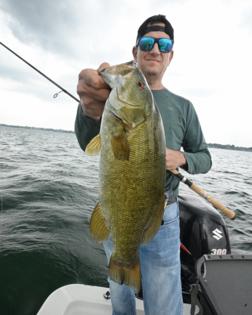Michigan's Lake St. Clair has a thriving fish that's driving anglers wild
Published in Outdoors
ST. CLAIR SHORES, Mich. — On a crisp, overcast morning on the dark, greenish-blue waters of Lake St. Clair, Dave LaVigne's fishing pole bowed like a candy cane as he reeled in what he hoped was a big fish.
A smallmouth bass fought, but LaVigne stayed focused. Wearing sunglasses and a baseball hat backward, he reeled and reeled until the fish, which was about two and a half pounds, was near the boat's edge. Then his fishing guide, Kevin Long, scooped it up with a small net.
That fish was "hangry," joked one of the anglers on the chartered fishing boat LaVigne was on as he reeled it up.
Smallmouth bass, long coveted by local anglers, have never been better in Lake St. Clair, said state natural resources experts and some local charter fishing owners. With a decline in their mortality rate, bass are living longer and, as a result, are bigger than they've ever been.
Thousands of people flock each year to Lake St. Clair to catch smallmouth bass, the season for which started recently. Michigan Department of Natural Resources officials said it's the best time to be a bass angler on the lake in at least the last 50 years.
Experts pointed to a number of factors for the lake's hearty smallmouth bass population, including catch-and-release decisions by anglers that have helped bass live longer and get bigger. The fish have also made invasive species such as round goby a part of their diet, though experts aren't certain whether this development has contributed to bass getting bigger.
"The good times are now, basically," said Jan-Michael Hessenauer, a fisheries research biologist at the DNR's Lake St. Clair Fisheries Research Station.
Hessenauer said the total number of bass in Lake St. Clair may have been higher in past decades, but there are more, larger fish now than before.
Hessenauer said the mortality rate of bass also has dropped, which he and his DNR colleagues think is likely because most anglers choose to release the bass they catch.
Long has worked as a fishing guide on Lake St. Clair since 1997 and said bass have increased in size over the last couple of years, according to bass tournament results. But he noted that over his career, he has seen years with good fishing and years with not-as-good fishing.
What the DNR study revealed
Hessenauer said the Lake St. Clair Fisheries Research Station started monitoring smallmouth bass in the lake in 1972 and continued until 1985. After taking a break, the station resumed monitoring bass from 2002 to 2023.
Smallmouth bass are an ecologically important species and an important game fish in Lake St. Clair, he said.
"They're popular to catch," Hessenauer said. "They draw in a lot of economic activity."
Smallmouth bass are the dominant bass species in the lake, he said. Largemouth bass are primarily confined to immediate nearshore areas, canals and tributaries.
The proportion of smallmouth bass over a given size has been steadily rising from 2002 to today, Hessenauer said. He and his team sampled 181 fish from all over the lake in spring 2025, and the average length was 17.3 inches. By comparison, in 2002, the average length was 14.3 inches.
The DNR's baseline assumption was that round gobies, a bottom-dwelling, invasive fish species that was introduced in the lake a few decades ago, were responsible for the increase. Round goby can eat quagga and zebra mussels, which are also invasive species, Hessenauer said. Round gobies are now an important part of the diet of smallmouth bass.
But the DNR researchers found that the smallmouth bass size increased the entire time that they studied the fish, Hessenauer said. From 1972 to today, there were similar rates of increase year-over-year. But round goby weren't observed in Lake St. Clair until 1990. So they don't appear to be responsible for the increased size.
Researchers found that the mortality rate of smallmouth bass has decreased, so they are living longer and reaching larger sizes. Bass continue to grow as they age.
Hessenauer said the decline in the mortality rate is likely because of the growing practice of catch-and-release.
"Most anglers now choose voluntarily to release the bass that they catch rather than harvesting them and, you know, taking them home to eat," he said.
Long shares his experience
Long, the owner of Longcast Guide Service based in Harrison Township, guided LaVigne, a Dexter resident, and Joe Greenwalt from Sylvan Lake on Long's 23 1/2-foot boat for an eight-hour chartered trip on Wednesday. The bass fishing season always starts the third Saturday of June, but anglers can catch-and-release the fish year-round.
Over a two-hour period, they caught eight fish. Most were between two and three pounds. At one point, Long and a Detroit News reporter caught a fish between four and five pounds.
They fished with artificial lures, which mimic the movement of the fish that bass eat. Each time they caught a fish, Long would use pliers to remove the lure from the bass' mouth.
Long said he has seen "ups and downs" with the bass population during his career, but he has seen the size of bass increase significantly over the last three years. He said he thinks this is due to good spawning seasons five to eight years ago.
Researchers have found that whether the nesting by bass, meaning how much they reproduce, is good or bad one year, a similar number of bass will be produced, the DNR's Hessenauer said. The spawning seasons appeared to be average in 2019 and 2021, he said.
Long said the lake has also been "teeming with food" for smallmouth bass in recent years, such as round goby and perch.
The weight of fish caught in bass fishing tournaments on Lake St. Clair has consistently increased over the last 10-12 years, he said.
"It's impressive enough that people want to come here for the fishing — if you're into fishing — from all over the place," said Long, comparing it with Pebble Beach, Calif., which is a destination for golfers.
On the topic of catch-and-release, Long said bass is seen as a sport fish — a species that is pursued for the thrill of catching it. Fishing magazines played a role in the national push for catch-and-release fishing that started in the early 1990s, he said.
Economic impact of fishing
John Bacarella, the owner of Sportsmen's Direct, a fishing store in Harrison Township, said people come from other states and sometimes other countries to fish on Lake St. Clair. Many bass fishermen stay at hotels on Hall Road and in Roseville, he said.
"And they're going to spend money at all the local businesses, whether it's a tackle store or whether it's a delicatessen or a restaurant," Bacarella said.
Fishing tournaments have helped make bass fishing on Lake St. Clair more well-known, he said. One such tournament, the 2025 Yokohama Tire Bassmaster Elite at Lake St. Clair, is scheduled to be held Aug. 7-10.
Capt. Steve Jones, a longtime fishing guide on Lake St. Clair, said he's also seen the average size of bass grow over the last couple of decades.
The lake has always had a good population of three-pound to three-and-a-half-pound bass, he said, but the odd fish "can really come in bigger," such as five pounds.
"There's ... a better chance to catch bigger fish now than there was in the past," Jones said.
Back on Long's boat, LaVigne caught fish after fish last Wednesday.
Long joked that "when the pressure's on," LaVigne "shuts his trap and reels them in."
But none of the bass went home with any of them. Each time they caught one, the fish was released from the hook and returned to the water, letting the bass to live longer and grow bigger.
©2025 The Detroit News. Visit detroitnews.com. Distributed by Tribune Content Agency, LLC.







Comments